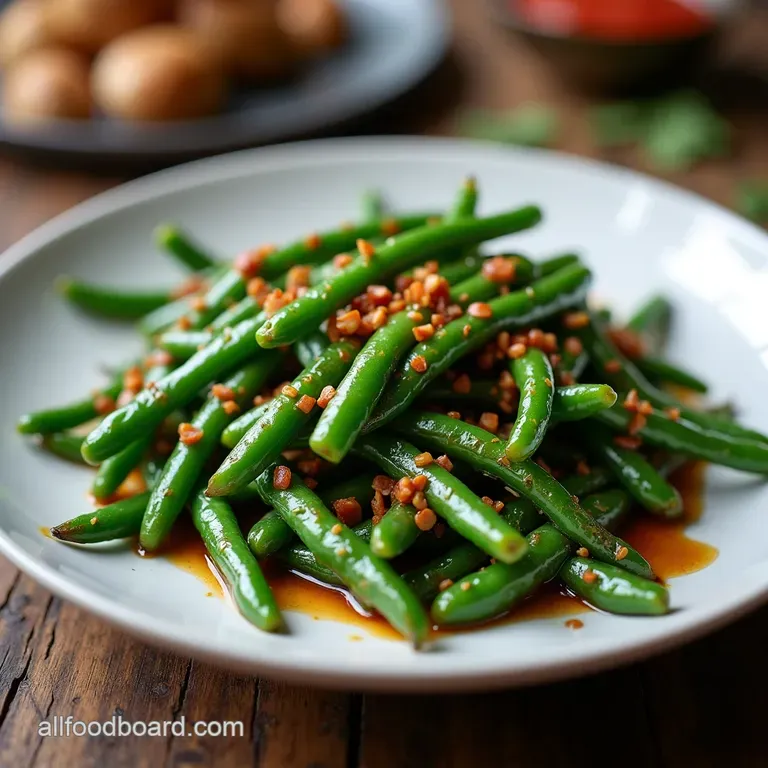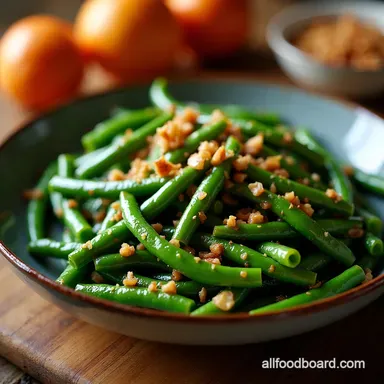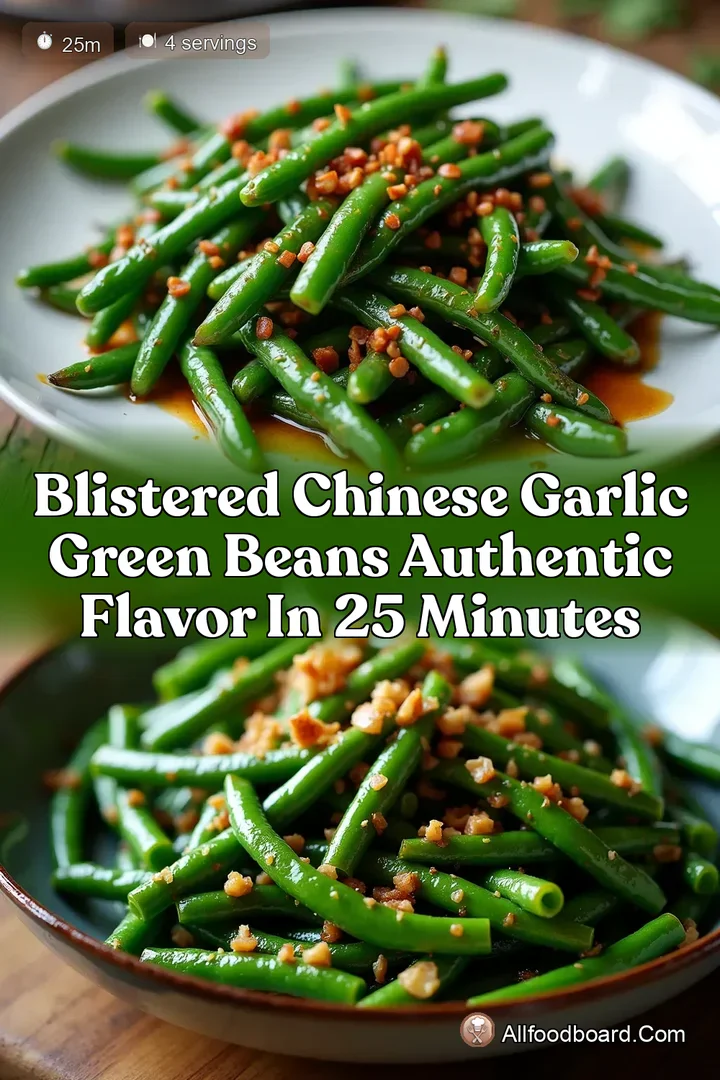WokKissed Wonders Blistered Chinese Garlic Green Beans with Savoury Soy Glaze

- The Alchemy of High Heat: Unlocking True Wok Char Flavor
- Why This Chinese Garlic Green Beans Recipe Outshines Takeout Standards
- Assembling the Core Components for Stellar Green Beans
- Crafting the Signature Savoury Glaze (The Umami Bomb)
- Phase One: Preparation and Initial Searing Technique
- Mastering the Stir-Fry: Achieving Optimal Blistering
- Elevating Your Side Dish: Flavor Variations and Enhancements
- Recipe FAQs
Blistered Garlic Green Beans 2

Ingredients:
Instructions:
Nutrition Facts
The Alchemy of High Heat: Unlocking True Wok Char Flavor
There is a magic that happens when humble vegetables meet searingly hot metal—a transformation that takes them from merely cooked to deeply flavorful. This is the essence of great Chinese cooking, and it’s precisely what we aim to capture when crafting authentic Chinese Garlic Green Beans . We aren't aiming for a soft, boiled side dish swimming in liquid; we are pursuing the delightful texture and smoky depth that only intense, dry heat can deliver. Mastering this technique is the key to elevating your everyday stir-fries and creating a side dish worthy of any renowned establishment, far surpassing the standard fare found at many local eateries.
Why This Chinese Garlic Green Beans Recipe Outshines Takeout Standards
The difference between a mediocre side dish and an unforgettable one often lies in respecting the process. Many home cooks inadvertently steam their vegetables because the pan isn't hot enough, resulting in limp, waterlogged results. This Chinese Garlic Green Beans Recipe is designed specifically to combat that sogginess by employing aggressive searing and quick saucing. When done correctly, these Asian Green Beans achieve an addictive, slightly wrinkled, and smoky exterior that holds its vibrant green color beautifully.
Defining 'Wok Hei': The Secret to Perfect Texture
The term 'wok hei' translates literally to "the breath of the wok," a complex, smoky flavor imparted by the superheated vapor and oil splashing against the food in a seasoned carbon steel wok. While achieving a true professional level of wok hei requires specialized equipment, we can mimic the effect by ensuring our home skillet or wok is screaming hot before the ingredients even touch the surface. This allows the natural sugars on the vegetable surface to caramelize rapidly rather than boil in their own moisture.
A Chef’s Promise: Crisp-Tender, Never Limp
Our goal for the final texture is "crisp-tender"—meaning the beans retain their vibrant color and offer a pleasing resistance (a "snap") when you bite into them, yet they are fully cooked through. This balance is achieved through precise timing during the Garlic Green Beans Stir Fry process. Overcooking by even a minute can tip the scales toward mush, which is what we actively avoid in this classic Chinese Style Green Beans preparation.
Setting the Scene: Essential Equipment for Success
While specialized woks are ideal, a high-quality, large, heavy-bottomed skillet—cast iron works surprisingly well—can handle the necessary high temperatures. The most critical piece of equipment, however, isn't the cooking vessel but your organizational system. Since the cooking time is mere minutes, having all components ready—the beans trimmed, the garlic and ginger minced, and the sauce whisked—is non-negotiable. This preparation, known as mise en place , ensures you can move fluidly through the high-heat steps without pause.
Assembling the Core Components for Stellar Green Beans
A successful Stir Fry Green Beans dish relies on three foundational elements: high-quality produce, pungent aromatics, and a perfectly balanced sauce. For this specific preparation, we are using approximately one pound (450g) of fresh green beans—Haricots Verts, which are thinner and cook faster, are a wonderful choice if available. These will be the star, demanding prime real estate in the hot wok.
Related Recipes Worth Trying
- The Proper Takeaway Treat Sizzling Szechuan DryFried Green Beans — Tired of soggy veg Master this Chinese Green Beans Stir Fry technique for blistered flavourpacked Asian Green Beans that taste better than takeout Get the...
- RestaurantStyle Chinese Green Beans With Garlic Sauce Recipe — Tired of soggy veg Master these authentic Chinese Green Beans With Garlic Sauce featuring perfectly charred blistered beans An easy Chinese side dish ready...
- Foolproof Crockpot Garlic Parmesan Chicken and Potatoes — This Easy Crockpot Chicken Dinner recipe is a weeknight lifesaver Tender chicken and potatoes swim in a rich Garlic Parmesan Sauce Get the simple slow...
Crafting the Signature Savoury Glaze (The Umami Bomb)

The flavour profile hinges on a quick, yet deeply satisfying glaze. This sauce needs to hit salty, sweet, and acidic notes simultaneously to complement the slight bitterness from the searing process. The foundation for this umami bomb relies on a combination of two tablespoons of soy sauce and one tablespoon of oyster sauce (or its vegetarian mushroom counterpart).
Procuring the Freshest Green Beans: Snap vs. Bend
When selecting your beans, remember the "snap test." A fresh bean should audibly snap when bent, indicating high moisture content and crispness. If the bean bends without breaking, it is already past its prime for high-heat cooking. Always trim off the tough ends before cooking begins.
The Garlic Factor: How Much is Enough for Intensity?
For true impact in this Chinese Garlic Green Beans preparation, we lean heavily on the garlic. Using a generous six large cloves, finely minced, ensures that when this aromatic hits the hot oil, it releases a potent, fragrant burst that permeates every bite. The key here is timing ; the garlic must be added late enough so it infuses the oil and coats the beans, but early enough that it doesn't scorch before the sauce goes in.
Beyond Soy Sauce: Balancing Sweetness and Acidity in the Sauce
To temper the saltiness of the soy and oyster sauces, we incorporate one teaspoon of granulated sugar and one teaspoon of rice vinegar. The sugar rounds out the flavour profile, while the vinegar provides a necessary acidic counterpoint, cutting through the richness of the oil and making the overall flavour profile feel brighter. A tablespoon of water or stock is added simply to ensure the sauce coats everything evenly rather than clinging solely to the bottom of the wok.
Phase One: Preparation and Initial Searing Technique
Once all ingredients are measured and assembled, the cooking phase begins, and it moves fast—about 8 to 10 minutes total. We start by preparing the aromatic powerhouse: finely mince your six cloves of garlic and about a teaspoon of fresh ginger. Next, in a small bowl, quickly whisk together the soy sauce, oyster sauce, rice vinegar, sugar, and the small splash of water. This is your glaze, ready to deploy.
Mastering the Stir-Fry: Achieving Optimal Blistering
This is where the commitment to high heat pays off. For the initial searing, you will need about three tablespoons of a high smoke-point oil, such as peanut or canola oil.
Prepping the Beans: Blanching Necessity (Or Lack Thereof)
Unlike many Western preparations, traditional, high-heat Chinese Buffet Green Beans recipes often skip blanching entirely. We rely on the intense heat of the wok to cook the beans just enough while creating char. If you absolutely prefer a slightly softer texture, a very brief 30-second dip in boiling water followed by an immediate ice bath is the maximum pre-treatment you should consider, but thoroughly patting them dry afterward is crucial.
The Crucial Step: Heating the Wok Beyond Smoking Point
Place your wok over the highest heat setting your range allows. Add 2 tablespoons of your chosen oil and let it heat until it is shimmering and just beginning to show wisps of smoke—it must be aggressively hot. This dry heat is essential for achieving that beautiful texture reminiscent of a professional Din Tai Fung Green Beans Recipe copycat.
Layering the Flavors: When to Introduce Aromatics
Add the trimmed green beans to the smoking oil, spreading them out slightly. Resist the urge to stir immediately! Let them sit for 1– 2 minutes to allow those desirable black blister marks to form. Once you see charring, begin tossing them vigorously for another three to four minutes until they turn bright green and reach that perfect crisp-tender stage. Next, push the beans to one side of the wok. Add the remaining tablespoon of oil to the clear side, drop in the minced garlic and ginger, and sauté for only about 30 seconds until fragrant. If the garlic burns here, you must start over, as it will impart an unpleasant bitterness to the entire dish.
The Grand Finale: Coating the Chinese Garlic Green Beans in Glaze
With the aromatics fragrant, immediately pour the pre-mixed sauce over everything. Toss rapidly and continuously for about one minute. The liquid will bubble, reduce, and thicken almost instantly, beautifully coating every one of those blistered Chinese Garlic Green Beans in a savoury, glossy sheen. Transfer them immediately to your serving plate; residual heat will continue cooking them if left in the pan.
Elevating Your Side Dish: Flavor Variations and Enhancements
While the classic garlic preparation is flawless, these Asian Green Beans are adaptable. A wonderful next step for those who enjoy heat is incorporating chili elements.
Spice it Up: Incorporating Chili and Ginger Alternatives
To introduce significant heat, add a teaspoon of Szechuan chili paste or flakes along with the garlic and ginger. Alternatively, incorporating thinly sliced fresh ginger alongside the garlic adds a sharper, earthier spice that complements the savoury glaze perfectly. For a funkier, more complex note, try stirring in a tablespoon of fermented black beans (douchi) right when you add the garlic.
Making it a Meal: Protein Pairings That Complement the Beans
These vibrant beans function beautifully as a side, but they can also anchor a light meal. They pair exceptionally well with simple, clean proteins like flaky steamed white fish drizzled with minimal sesame oil, or alongside crispy, dry-fried tofu cubes tossed in five-spice powder.
Nutritional Snapshot: Understanding the Health Profile
These Chinese Garlic Green Beans are naturally low in saturated fat and boast a respectable fiber content thanks to the substantial vegetable load. The primary caloric contribution comes from the healthy cooking oil used for searing. Always be mindful of the sodium content, which is largely determined by the type of soy and oyster sauces you select.
Troubleshooting Common Issues: Avoiding Steamed, Soggy Results
The most common error is overcrowding the wok. If you add too many beans at once, the temperature drops dramatically, and the water released from the beans has nowhere to go but to steam them. If your pan is smaller, work in two batches. Next,, if your sauce seems too thick and gloppy, simply add another tablespoon of water or stock while tossing to achieve that glossy coat rather than a sticky paste. Embrace the high heat, and your Chinese Garlic Green Beans will consistently deliver that perfect, smoky crunch.

Recipe FAQs
What's the secret to getting those lovely charred spots on the Chinese Garlic Green Beans?
That gorgeous char is called 'blistering,' and it requires seriously high heat—think properly smoking hot wok! You must resist the urge to stir immediately; let the beans sit undisturbed on the hot surface for a minute or two so they can sear before you toss them. It's all about that 'wok hei'!
My garlic always burns before the beans are cooked; what am I doing wrong?
Ah, the age-old garlic dilemma! Garlic cooks much faster than the beans, so you need to add it near the very end. After the beans are blistered and nearly done, push them to the side, add a splash more oil, quickly sauté the garlic for about 30 seconds until fragrant, and then immediately toss it all with the sauce.
Can I make these ahead of time, or should they be eaten straight away?
For the best texture, these are absolutely best eaten immediately, piping hot, while the beans still have their satisfying snap. If you must make them ahead, store them loosely covered in the fridge and reheat them quickly in a very hot, dry skillet to revive some of that crispness.
I'm vegetarian; what’s the best swap for the oyster sauce in the glaze?
No problem at all! The key flavour note from oyster sauce is rich umami depth. You should substitute it with a high-quality Vegetarian Mushroom Sauce—this is readily available in most big supermarkets nowadays. It gives you that savoury backbone without any animal products.
Are these green beans supposed to be soft or still crunchy?
They should be crisp-tender, which means they are fully cooked through but still retain a lovely, definite crunch—not mushy like boiled beans! This contrast between the tender interior and the charred exterior is what makes this dish so smashing.
How can I make these Chinese Garlic Green Beans spicier, in a proper Szechuan style?
If you fancy turning up the heat, you've got a couple of excellent options. Add a teaspoon of Szechuan chili flakes along with the garlic, or stir in some chili oil during the final glazing stage. For a deeper, more authentic heat, try adding a teaspoon of fermented black beans (Douchi) when you sauté the garlic.